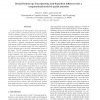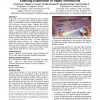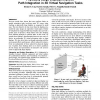40 search results - page 8 / 8 » Visualizing System Factorizations with Behavior Tables |
ASSETS
2008
ACM
13 years 7 months ago
2008
ACM
Due to the profile of strengths and weaknesses indicative of autism spectrum disorders (ASD), technology may play a key role in ameliorating communication difficulties with this p...
CVPR
2007
IEEE
14 years 7 months ago
2007
IEEE
A critical function in both machine vision and biological vision systems is attentional selection of scene regions worthy of further analysis by higher-level processes such as obj...
ICMI
2004
Springer
13 years 10 months ago
2004
Springer
Understanding human-human interaction is fundamental to the long-term pursuit of powerful and natural multimodal interfaces. Nonverbal communication, including body posture, gestu...
TEI
2012
ACM
12 years 28 days ago
2012
ACM
In the real world, touch based interaction relies on haptic feedback (e.g., grasping objects, feeling textures). Unfortunately, such feedback is absent in current tabletop systems...
CHI
2004
ACM
14 years 5 months ago
2004
ACM
Previous results have shown that users perform better on spatial orientation tasks involving static 2D scenes when working on physically large displays as compared to small ones. ...



